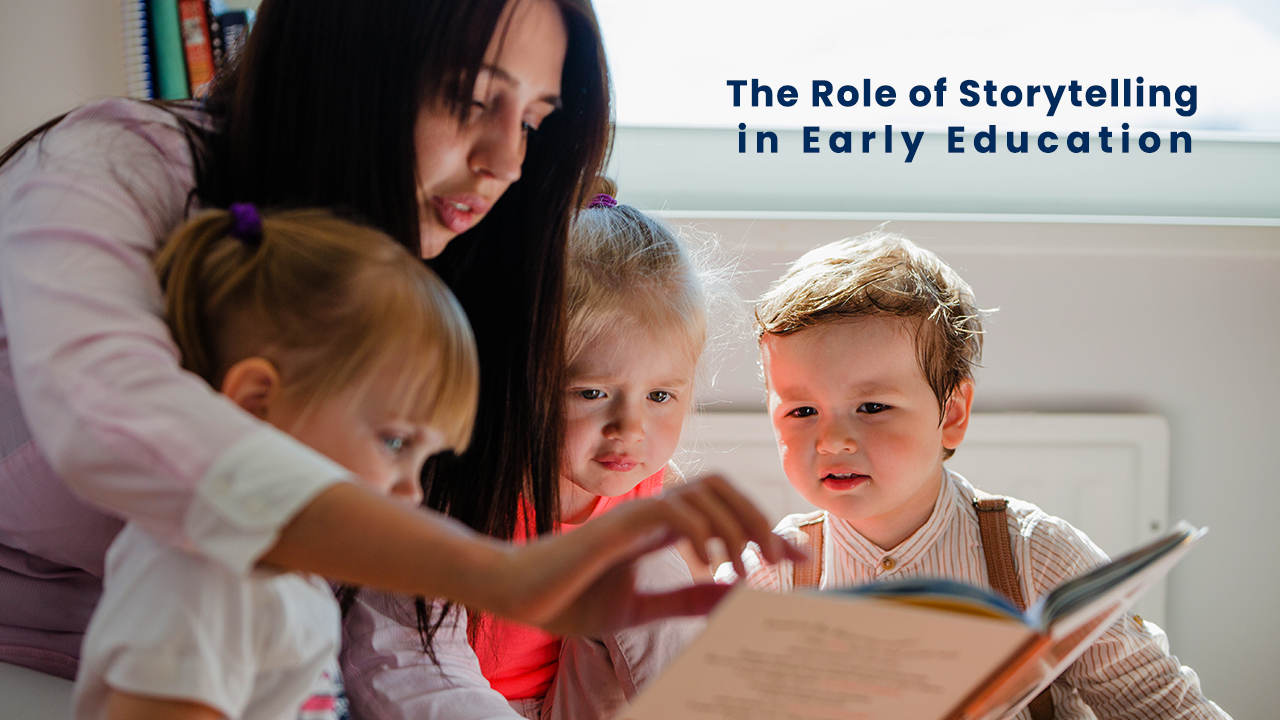
Storytelling is an age-old tradition transcending generations as an assertive communication, entertainment, and education tool. In early childhood development, storytelling takes on a profound significance. In this blog, we will explore the enchanting role of storytelling in early education and delve into its pivotal role in shaping the minds and hearts of young learners.
Unveiling the Effects of Storytelling in Early Education on Childhood Brain
Enhanced Language Skills:
Storytelling acts as a linguistic catalyst for young minds. Children naturally expand their vocabulary through exposure to diverse words, sentence structures, and expressive language in narratives. The auditory and visual richness of storytelling provides an immersive context for language acquisition, laying a solid foundation for effective communication and a lifelong love of language.
Cognitive Processing:
Beyond language development, storytelling engages children in cognitive exercises. Following a narrative prompts active engagement with plotlines, characters, and settings, fostering critical thinking. Making connections and predicting outcomes during storytelling sessions exercises cognitive abilities, laying the groundwork for advanced problem-solving skills. This mental stimulation enhances their analytical capabilities and contributes to overall cognitive flexibility, which is crucial for adapting to diverse learning environments and challenges.
Empathy and Emotional Recognition:
The impact of storytelling on emotional intelligence is profound. Immersed in narratives, children forge emotional connections with characters, experiencing various feelings. This engagement nurtures empathy as children vicariously navigate the emotional landscapes of the story. Through diverse characters and experiences, children learn to recognize and understand a spectrum of emotions, fostering emotional intelligence that extends beyond storytelling to enrich their interpersonal relationships and empathetic understanding of the world around them.
Moral Development:
Stories often serve as ethical compasses, guiding children through moral dilemmas and ethical considerations. As characters face challenges and make decisions, children are exposed to the fundamental concepts of right and wrong. This exposure contributes to developing a child’s sense of morality, helping them shape their ethical framework and make informed choices based on a foundation of values instilled through the narratives they encounter.
Strengthening neural pathways:
Storytelling engages various regions of the brain associated with comprehension, imagination, and memory. This activation of neural pathways during storytelling contributes to the strengthening of synaptic connections. Children’s brains actively process information as they follow narratives, creating a more interconnected cognitive framework. This neural plasticity, fostered by storytelling, plays a pivotal role in shaping the brain’s adaptability and ability to learn, laying the groundwork for future intellectual growth.
Enhanced Attention Span:
Regular exposure to storytelling contributes significantly to developing a child’s attention span. The immersive nature of narratives captivates young minds, encouraging sustained focus over extended periods. This cultivated attention span becomes a valuable asset in academic settings, where concentrating for prolonged periods is essential for effective learning and comprehension.
Formation of Social Bonds:
Shared storytelling experiences create powerful social bonds among children. Whether listening to stories in a group setting or enjoying tales one-on-one, these shared narratives foster connections. The communal aspect of storytelling encourages children to engage meaningfully with peers, educators, and parents, promoting a sense of belonging and community.
Development of Social Skills:
Interactive elements within storytelling, such as discussions and role-playing, contribute significantly to developing essential social skills. Children learn to articulate their thoughts, share perspectives, and engage in collaborative activities. These social interactions enhance communication skills and cultivate positive behaviors, laying a foundation for successful interpersonal relationships as they navigate the social landscapes of their academic and personal lives.
Forms of Storytelling in Early Education
Oral Storytelling:
The spoken word holds a special place in early education. Teachers and caregivers often engage in oral storytelling, using expressive language, varied tones, and gestures to bring stories to life. This form enhances language development and promotes active listening skills among young learners.
Picture Books:
Picture books combine visuals with simple narratives, making them integral to early childhood education. The vibrant illustrations complement the storyline, providing visual cues for comprehension and vocabulary development. Picture books are a gateway to cultivating a love for reading from a young age.
Interactive Storytelling:
Interactive storytelling encourages active participation from young listeners. Teachers may use props puppets, or ask questions during the narrative, inviting children to engage with the story. This form sustains attention and promotes critical thinking and verbal expression among preschoolers.
Digital Storytelling Apps:
With the integration of technology in early education, interactive apps designed for storytelling have gained popularity. These apps often feature animated characters, interactive elements, and age-appropriate content, providing a multisensory experience that aligns with the technological fluency of today’s young learners.
Role-Playing and Dramatic Play:
Incorporating storytelling into role-playing and dramatic play allows children to act out narratives themselves. This hands-on approach enhances comprehension and promotes social skills as children collaborate and negotiate roles within the imaginative context of the story.
Rhymes and Songs:
Rhymes and songs are rhythmic forms of storytelling that contribute to early language development. Whether through traditional nursery rhymes or specially crafted educational songs, these forms introduce patterns, phonetics, and vocabulary engagingly and memorably.
Storytelling Through Art:
Art becomes a storytelling medium in early education, where children can create illustrations or drawings inspired by narratives. This form allows them to express their story interpretation visually, fostering creativity and fine motor skills.
Storytelling Through Play:
Play is an essential avenue for storytelling in early education. Children often construct narratives through imaginative play with toys, developing storytelling skills as they create scenarios, characters, and plotlines in their play.
Cultural and Diversity-Focused Storytelling:
Introducing children to stories from diverse cultures and backgrounds broadens their perspectives and nurtures an appreciation for diversity. This form of storytelling in early education promotes cultural understanding and inclusivity.
Sequential Storytelling and Story Sequencing:
Utilizing sequences or storyboards aids in developing children’s understanding of narrative structure. Teachers may use visual aids or story-sequencing activities to help children grasp the chronological order of events within a story.
Conclusion:
Storytelling in early education emerges as a dynamic force that nurtures creativity, fuels cognitive development, cultivates emotional intelligence, and enhances social skills. Educators and parents pave the way for a magical learning journey that goes far beyond the pages of a storybook by incorporating storytelling into educational practices, whether through books, oral traditions, or interactive activities. Through the art of storytelling, we open the door to a world where imagination knows no bounds and the seeds of lifelong learning are sown. You can also learn more about soft skill development in daycares here.


